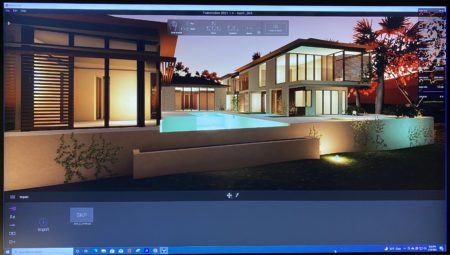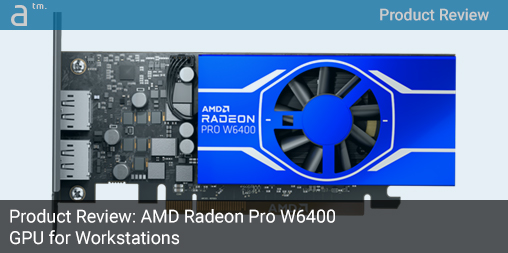Continued from page 2
SketchUp TTD FPS Tests
As we just noted in our last GPU review, SketchUp is quite symbolic of the prevalence of “CPU, frequency-bound” CAD industry applications. As Trimble notes, SketchUp is not multithreaded. In this way, it is very much like most BIM and CAD applications. We like testing with it because we can take our tests across platforms, which has always been important to our audience.
The question that one might want to know about the W6400 GPU is, is it good enough for massive SketchUp work? As we will see in the chart below, the answer is most definitely.
Our three test files range in size from 1.3, 13, and 200 megabytes. We run the “Test.time_display” FPS test that Trimble has shared in its user forums. You can learn more from our last article about these tests and how to run your own SketchUp TTD FPS tests.

Chart 10: SketchUp TTD FPS Tests for Combined Architosh SU Models. Longer bars are better. Reader beware, the numbers in the bars matter more than their graphical lengths in the chart. Keynote can be funny about things! (Image: Architosh / All rights reserved.)
As you can see from the composite scores from our SketchUp TTD FPS test, the Radeon Pro W6400 performed at 93 percent of the speed of its bigger sibling GPU, the W6600. As noted here and here, going beyond the Radeon Pro line’s mid-level GPU isn’t going to gain you much. The one caveat would be those working with files much larger than our 200MB file with tons of textures and when one is working with shadows and effects like fog.
Twinmotion and Raytracing
We spent so much time testing the Radeon Pro W6400 in benchmarks like SPECviewperf 2020, doing more thorough SketchUp tests and recordings, that this review had to give a bit somewhere. We quickly ran through our Twinmotion file and noticed that the image quality was clearly on par with both the AMD Radeon Pro W6600 and the recently reviewed NVIDIA RTX A200o. (Image 5)

Image 5: Twinmotion file testing for raytracing and Viewport Boost. (Image: Architosh / All rights reserved.)
We navigated, panned, zoomed, and selected elements and generally felt that the AMD Radeon Pro W6400 did a pretty darn decent job at Twinmotion. You can see we had AMD Radeon Pro software’s performance overlay stats on the upper right in the image above. Note, we are at full capacity with the VRAM and nearly 100 percent GPU utilization. This image was captured doing a lateral pan.
Compared to the aforementioned two GPUs above, micro stutters were a tad bit more noticeable. During panning operations or camera pans moving in and out, frame rates were still quite smooth.
Conclusions and Recommendations
The AMD Radeon Pro W6400 was built for a wide audience of pro users, across multiple markets. It is designed to address both modern, multi-function business workloads (from video calls to Excel to photo editing) while also being suited as a GPU entry-point for CAD/BIM workstations, especially small-form factors (SFF) workstations.
As an entry-level workstation GPU, this unit shines in two areas. Firstly, by delivering excellent performance for “shaded with edges” typical CAD workflows, including in MCAD tools (not just AEC) and especially on a performance per dollar basis. And secondly, by delivering real-time raytracing to power those same users just mentioned who on occasion venture into real-time rendering tools (particularly growing in AEC).
There is so much to like in this Radeon Pro W6400, from its SFF flexibility to its astounding price and performance per dollar metrics. This is an excellent GPU workstation option for more senior-level staff in architecture offices who need to access BIM and 3D models on a half-time or less basis and infrequently render. On a comparative return on investment basis, it is questionable if spending twice as much on the more powerful NVIDIA RTX A2000 would be as smart as taking that extra 230 USD and upgrading to a higher-performing CPU. If you live in the land of designing in OpenGL “shaded with edges” rendered viewports, the AMD Radeon Pro W6400 is smart money!
Pros: Industry-leading performance per dollar for an entry-class workstation GPU; offers real-time raytracing at the lowest price point for workstation-class GPUs in the industry; Comes with two bracket sizes to fit into SFF or normal-sized computers; offers the same benefits as Infinity Cache and Viewport Boost as its bigger AMD RDNA 2 Architecture siblings; the fan is silent, unlike the fan we heard on the NVIDIA RTX A2000.
Cons: Fewer pro apps leverage the new hardware-accelerated raytracing technology in the new AMD Radeon Pro W6400, compared to NVIDIA’s RTX technology, but that can change over time. At this moment, 3ds Max, Revit, Twinmotion, and Unreal are optimized.
Advice: The AMD Radeon Pro W6400 takes up a unique solo position in the workstation industry, offering a special blend of very low price, real-time raytracing support, VR readiness, and strong economics for most OpenGL CAD apps at the cost-constrained low-end of the workstation market.
Costs: 229 USD MSRP




Reader Comments
Comments for this story are closed